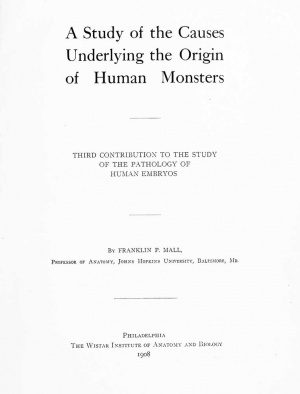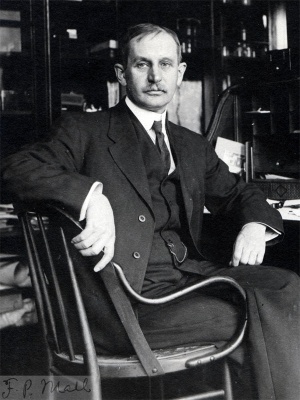Paper - A study of the causes underlying the origin of human monsters
| Embryology - 28 Apr 2024 |
|---|
| Google Translate - select your language from the list shown below (this will open a new external page) |
|
العربية | català | 中文 | 中國傳統的 | français | Deutsche | עִברִית | हिंदी | bahasa Indonesia | italiano | 日本語 | 한국어 | မြန်မာ | Pilipino | Polskie | português | ਪੰਜਾਬੀ ਦੇ | Română | русский | Español | Swahili | Svensk | ไทย | Türkçe | اردو | ייִדיש | Tiếng Việt These external translations are automated and may not be accurate. (More? About Translations) |
Mall FP. A study of the causes underlying the origin of human monsters. (1908) J Morphol. 19: 3-368.
| 1908 Mall TOC: Historical | Double Monster | Lithium embryos | Salts of potassium and heart | Spina bifida and anencephaly | Cyclopia and club-foot | Pathological ova | Twin pregnancies | Unruptured tubal pregnancies | Ruptured tubal pregnancies | Amnion Destruction | Moles | Pathological ova umbilical cord and amnion | Second week | Third week | Fourth week | Fifth week | Sixth week | Seventh week | Eighth week and older | Specimens and figures | Plates | Historic Papers | Franklin Mall |
| Historic Disclaimer - information about historic embryology pages |
|---|
| Pages where the terms "Historic" (textbooks, papers, people, recommendations) appear on this site, and sections within pages where this disclaimer appears, indicate that the content and scientific understanding are specific to the time of publication. This means that while some scientific descriptions are still accurate, the terminology and interpretation of the developmental mechanisms reflect the understanding at the time of original publication and those of the preceding periods, these terms, interpretations and recommendations may not reflect our current scientific understanding. (More? Embryology History | Historic Embryology Papers) |
A Study of the Causes Underlying the Origin of Human Monsters
(Third Contribution To The Study Of The Pathology Of Human Embryos.)
Professor of Anatomy. Johns Hopkins University. Baltimore. Mn.
Online Editor - Please note the term "monster" is the historic term for gross developmental abnormalities and is both no longer used and also offensive. It has been left within this text as this is how such major abnormalities were medically referred at that time, and I apologise for any offence this term may cause.
Table of Contents
Introduction
PART I
Experimental
PART II
Introduction
The present communication is the outcome of a study of 163 pathological human embryos which I have collected during the past fifteen years. The first contribution[1] which I made to this subject included a report of 53, and the second[2] of 20 of these embryos. These two studies are rather anatomical in nature and do not consider the causes which produce pathological embryos, nor their relation to ordinary human monsters. A more careful study of my specimens, which have more than doubled in number during the past five years, establishes beyond doubt (1) the identity of pathological embryos and small monsters, that is, many of them would have developed into real monsters if they had not been aborted, and (2) that all of them are developed from normal ova due to external influences,—in man to a condition which I shall term faulty implantation.
From the earliest ages in the world’s history the study of monsters, and the causes which produce them, has been one of the capital problems in anatomy, medicine and natural history. Supernatural causes for the production of monsters, like the influence of the gods, celestial or diabolical, or lunar influences, as expressed in their name, monster or moon—calf, held for a long time universal sway and are still believed in by many ignorant people. However, the Greek naturalists and physicians were inclined to ascribe them to natural causes, which belief was gradually displaced in the Dark Ages by the one that monsters were hybrids of bestial origin, a theory which was finally overthrown in the eighteenth century. Equally general has been the theory that maternal impressions affect the offspring and convert them into monsters. This belief is of great antiquity, and is at present of world-wide distribution. It also was attacked in the eighteenth century, first by Blondel from a philosophical and then by Haller from a scientific standpoint.
All the theories can be resolved into the simple question: “Are the conditions which produce a monster germinal and therefore hereditary, or are they produced from normal germs by external influences?” The discussion on both sides of the question has been a long one, conducted during many years by the ablest masters, among whom are always included the leading anatomists of the time. However, the theory of external influences gradually gained ground during the nineteenth century, as the science of embryology was cultivated more and more. But here again we have two schools, the one believing that monsters are formed from normal germs due to maternal impressions, the other that they are due to mechanical influences. It may be noted here that the obstetricians and gynecologists of America as a class advocate strongly the theory of maternal impressions, due largely, no doubt, to their insufficient scientific education. On the other hand, we may pride ourselves over the masterful strokes of American teratologists against this theory; the experimental teratologists have produced double monsters, spina bifida and cyclopia, under the very noses of these practitioners, but they continue their futile speculations over mere coincidences.
With Meckel, who laid the embryological foundation for a scientific teratology, and the Saint-Hilaires, who made the first teratological experiments, we have the beginning of the development of the mechanical theory. It appears in a variety of forms, as, for example, that monsters are due to tight lacing which causes pressure upon the embryo, or to the contracting uterus which naturally might have the same effect. However, this theory was gradually transformed by teratologists so that now it rests upon the idea that amniotic bands constrict or compress the embryo, thus bringing about its deformity. Occasionally it has been found that monsters are attached to the chorion through newly-formed bands of tissue, and such bands, whether present or not, are held responsible for all terata. This coincidence, as I term it, cannot be of frequent occurrence, for usually there is present an hydramnios. Nor can even the “coincidence” occur in anamniotic animals. Furthermore, no amniotic bands were ever found in any of the 169 specimens which I have studied.
In place of these theories it is my purpose to demonstrate that all monsters are produced by external influences upon normal ova which affect the nutrition of the embryos due to faulty implantation of the ovum. That the power to become a monster is present in every ovum is fully demonstrated by experiments upon a variety of vertebrates as well as by all of my pathological ova, especially those obtained from tubal pregnancies.
The changes found repeatedly in the chorion are no doubt primary; they are usually of an hemorrhagic nature, often indicating inflammatory changes in the uterus. I shall only hint at the cause for the changes in the uterus, which may interfere with the formation of the decidua, and recommend this field as a very fertile one for gynecologists and obstetricians to investigate. At any rate, the change interferes much with the attachment of the ovum, and this condition and what results from it I have termed faulty implantation.
It has been impossible, in fact it is not desirable, to discuss extensively the immense amount of excellent literature upon teratology. The whole makes one of the best chapters in medical literature to which the greatest minds of medicine have contributed their best efforts. One cannot go through these writings, many of which are comprehensive, without laying them aside with profound respect. In this study I have used many of them freely, but make, however, very few references.[3] I have also avoided technical terms as much as possible, and in general have adopted Ballantyne’s classification, which, in turn, is based upon Tarufii’s.
I wish it were possible to thank adequately the many physicians who have contributed the specimens and who have responded so generously to my many inquiries. All data obtained from them are given in quotations under the description of the specimens, which are also properly credited to the donors. Some names will be seen repeatedly, as Miller, Boldt, Lamb, Brodel, Ballard, West and Minot. In addition, I wish also to thank my colleagues at the Johns Hopkins, who have aided me in every possible way to bring together the gynecological, obstetrical, pathological and experimental embryological evidence.
In this paper all of the embryos mentioned in the two previous ones are discussed, and brought together in Part II. The essence of the first contribution is given, and all of the second contribution is incorporated in this publication, so in a measure it may be viewed as a study of the whole collection. However, the various steps by which I came to arrange the specimens, as I have, can be understood only by consulting the two previous publications.
III, which was to be the important part, never appeared. Fortunately, however, Ah1fe1d’s library, which is very complete, was presented to the Johns Hopkins University. This I have consulted freely and in a way it makes up for the missing Part III.
Marchand, Missbildungen, Eu1enburg’s Real-Encyclopedia, 3d edition, I897, Vol. XV.
Taruffi, 'Storia delli Teratologia, 8 volumes, Bologna, I881-I895.
Hirst and Piersol, Human Monsters, Philadelphia. ,
Piersol, Teratology, Ref. Hndbk. Med. Sci., new edition, Vol. VII, I . 9o4
Ballantyne, Antenatal Pathology, 2 volumes, Edinburgh, 1904.
E. Schwalbe, Die Morphologie d. Missbildungen des Menschen und der Thiere, Jena, Pt.- I, 1906, Pt. II, I907.
References
- ↑ Mall, Welch Festschrift, Johns Hopkins Hospital Reports, IX, 1900.
- ↑ Mall, Vaughan Festschrift, Contributions to Medical Research, Ann Arbor, 1903.
- ↑ J. F. Meckel, Handbuch d. pathol. Anatomic, Leipzig, I812. Ffirster, Die Missbildungen des Menschen, Jena, 1865.; Bischoff, Wagner’s Handwfirterbuch, 1842.; Ahlfeld, Die Missbildungen des Menschen, Leipzig, 1880-1882.
Cite this page: Hill, M.A. (2024, April 28) Embryology Paper - A study of the causes underlying the origin of human monsters. Retrieved from https://embryology.med.unsw.edu.au/embryology/index.php/Paper_-_A_study_of_the_causes_underlying_the_origin_of_human_monsters
- © Dr Mark Hill 2024, UNSW Embryology ISBN: 978 0 7334 2609 4 - UNSW CRICOS Provider Code No. 00098G


